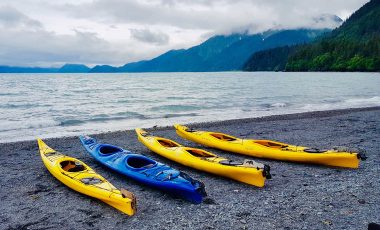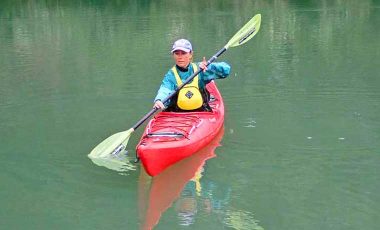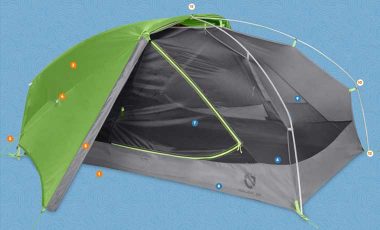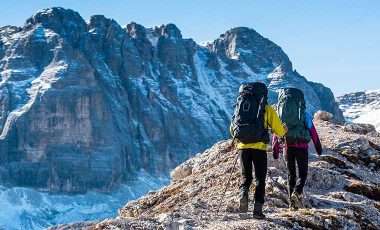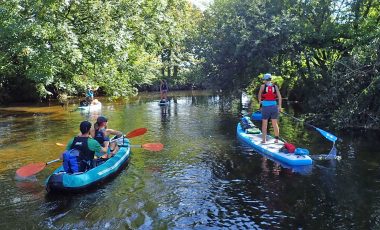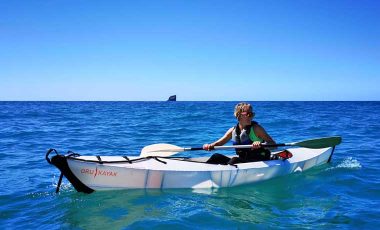Do you know the anatomy of a kayak? Ever wondered what all the parts of a kayak are called and what they’re for? For anyone new to kayaking, the technical jargon can be a lot to take on. Even experienced kayakers may not know their bow from their stern or a scupper from a coaming.
But why is it important to know the different parts of a kayak anyway? Like all outdoor equipment, not all kayaks are made the same. Some are best for riding river rapids, while others are designed to cover long distances over the sea or on lakes, or move quickly along rivers. Knowing the basic parts of a kayak and the parts of a kayak paddle will help you choose the best kayak for you.
In this article, we’re going to break down and explain the basic parts of a kayak.
- What is a kayak?
- The anatomy of a kayak
- Basic Parts of a kayak explained
- Parts of a kayak paddle explained
What is a kayak?
A kayak is a non-motorised vessel that’s propelled with a two-bladed paddle. Kayaks are paddled from a seated position, usually by one or two people.
If you’re getting kayaks confused with canoes, then read our guide to canoes and kayaks which explains the similarities and differences of the two types of boats and the pros and cons of each.
Kayaks are one of the most diverse types of boats in the world of water sports because there are so many variations. Some kayaks are over twenty-feet long and narrow with a raised and pointed bow. On the opposite end of the scale, some kayaks are less than eight feet long, are wide, have a low-profile and a rounded bow.
The most obvious difference is between sit-inside kayaks (in which your legs are covered) and sit-on-top kayaks. The best thing about kayaking is that you can use a kayak on almost any water, depending on which type of kayak you choose.
Fun fact… The word ‘Kayak’ comes from the Greenlandic word ‘Qajaq’ meaning ‘Hunter’s boat’. Indigenous Arctic people primarily used kayaks for hunting.
A brief history of the kayak
The earliest kayaks were developed over 4,000 years ago by the Indigenous Inuit, Yupik and Aleut peoples who lived in the Arctic regions of North America. In these frozen regions, the people built their kayaks either from driftwood or by stretching animal skins over wood or bone frames. The kayaks were waterproofed, either with tree-resin or animal fats.
Fun fact…The oldest surviving kayaks date back to 1577. They are on display at the Museum of Five Continents in Munich, Germany.
In the Arctic, there were two main types of early kayak: one was long, narrow, and made for the sea, and one was shorter and wider, with the ability to carry gear. Around the mid-1800s, the kayak arrived in Europe and became popular in Germany and France.
Fun fact… Kayaking became a popular recreational sport for men in Western Europe in the mid-1800s and became part of the Olympic games in Berlin, 1936.
Construction materials have changed drastically over the years. Europeans made their kayaks from waterproofed fabric instead of skins. In the 1950s, fibreglass kayaks were introduced and followed, thirty years later, by plastic kayaks. Nowadays, most kayaks are made from moulded plastic or fibreglass.
The anatomy of a kayak
If you’re planning to buy your first kayak or you’re looking for an upgrade, but you’re still unsure what the different parts of a kayak are called, our kayak parts diagram showing the basic parts of a kayak should help you visualise it.
Below, we’ve also explained what each of the kayak parts is, so you can identify it. And, what each part does, so you know it’s purpose. Once you’re familiar with kayak anatomy, you should feel more confident choosing the right one for you.
Kayak parts diagram
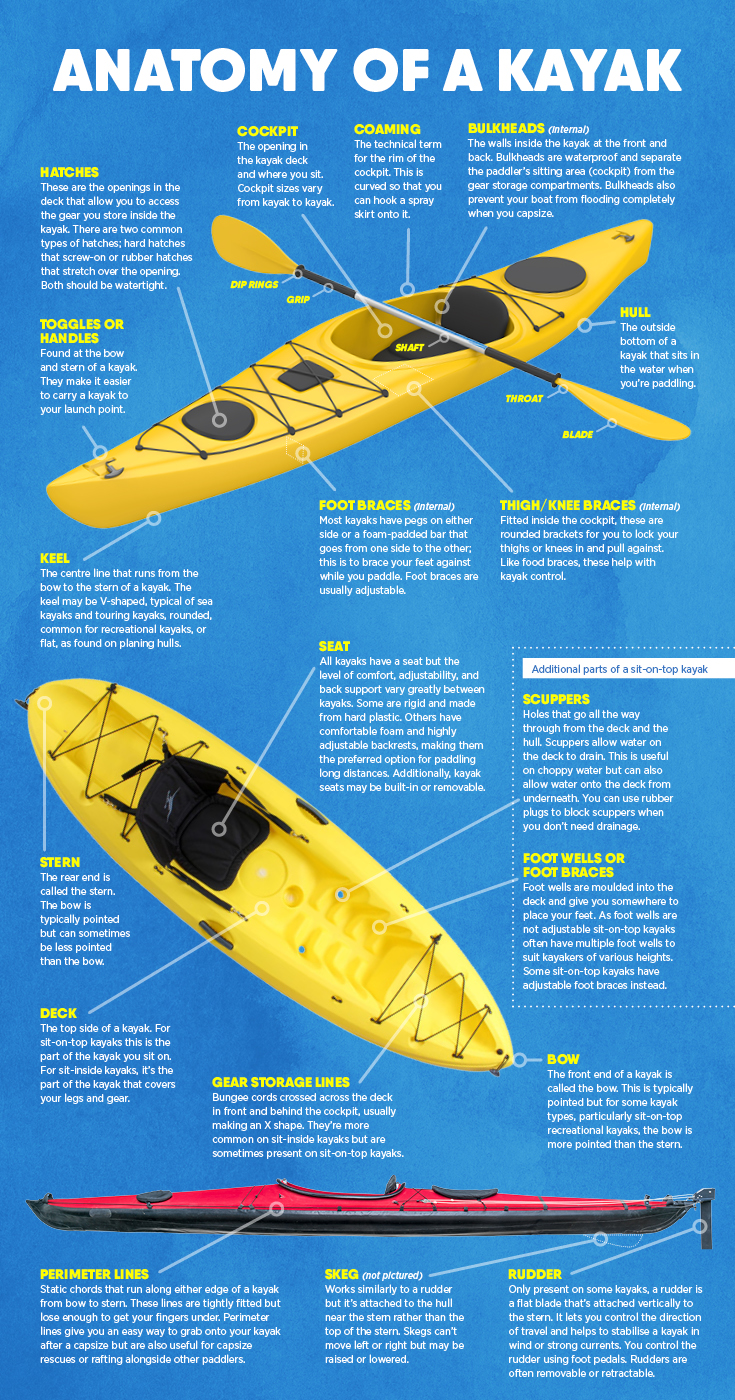
Share this image on your site
What are the parts of a kayak?
The basic parts of a kayak:
- Bow
- Stern
- Hull
- Keel
- Deck
- Rudder
- Skeg
- Seat
- Hatches
- Deck lines
- Toggles or handles
Basic Parts of a sit-inside kayak:
- Cockpit
- Coaming
- Foot braces
- Thigh/knee braces
- Bulkheads
- Compass recess
Basic parts of a sit-on-top kayak:
- Scuppers
- Foot wells or foot braces
- High-low seat
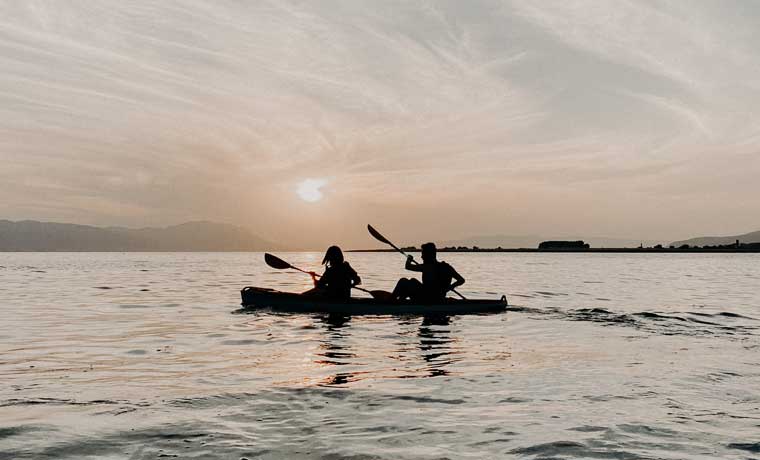
Basic Parts of a kayak, explained
Because there are so many different types of kayaks, there are variations in the features that they have. Not all kayaks have every feature. This section is split into three parts:
- Common parts of sit-inside and sit-on-top kayaks
- Additional parts of a sit-inside kayak
- Additional parts of a sit-on-top kayak
Common parts of sit-inside and sit-on-top kayaks
This section covers the most common parts of kayaks that are usually found on most sit-inside and sit-on-top kayaks.
Bow vs stern
Do you know the kayak bow from the stern? Like any other type of boat, the front end of a kayak is called the bow while the rear end is called the stern. Both the bow and stern are typically pointed but, for some kayak types, particularly sit-on-top recreational kayaks, the bow is more pointed than the stern.
When talking about length, measure the length from the stern of a kayak to the bow.
Deck
The top side of a kayak. For sit-on-top kayaks this is the part of the kayak you sit on. For sit-inside kayaks, it’s the part of the kayak that covers your legs and gear.
Hull
What is the hull of a kayak? The hull is the bottom of a kayak, meaning the part that sits in the water when you’re paddling. There are two main types of kayak hull:
- Displacement hull: The more common of the two types, displacement hulls are long, slim, and rounded. They are better at moving fast and straight. Displacement hulls typically have a V-shaped keel (centreline) which improves tracking.
- Planing hull: Often found on whitewater kayaks and playboats, planing hulls have a flat-bottomed keel and sharply angled sides. They are quick to turn and can move fast as they skim the water but are difficult to keep in a straight line.
Keel
The centre line that runs from the bow to the stern of a kayak. The keel may be V-shaped, typical of sea kayaks and touring kayaks, rounded, common for recreational kayaks, or flat, as found on planing hulls.
Rudder
Only present on some kayaks, a rudder is a flat blade that’s attached vertically to the stern. It lets you control the direction of travel and helps to stabilise a kayak in wind or strong currents. You control the rudder using foot pedals. Rudders are often removable or retractable.
Skeg
Works similarly to a rudder but it’s attached to the hull near the stern rather than the top of the stern. Skegs can’t move left or right but may be raised or lowered.
Seat
All kayaks have a seat but the level of comfort, adjustability, and back support vary greatly between kayaks. Some are rigid and made from hard plastic. Others have comfortable foam and highly adjustable backrests, making them the preferred option for paddling long distances. Additionally, kayak seats may be built-in or removable.
Hatches
These are the openings in the deck that allow you to access the gear you store inside the kayak. There are two common types of hatches; hard hatches that screw-on or rubber hatchesthat stretch over the opening. Both should be watertight.
Kayak hatches are more commonly found on sit-inside touring kayaks and sit-inside sea kayaks. There is usually one hatch at the front of the deck and one at the back deck. However, some sit-inside kayaks also have a third hatch, called a day hatch, which is within arms-reach of the paddler. Some sit-on-top kayaks also have a kayak hatch in the centre of the kayak.
Deck lines
These are the ropes on the deck of a kayak. Deck lines include:
- Perimeter lines: A static chord that runs along either edge of a kayak from bow to stern. These lines are tightly fitted but lose enough to get your fingers inside. Perimeter lines give you an easy way to grab onto your kayak after a capsize but are also useful for capsize rescues or rafting alongside other paddlers.
- Gear storage lines: Bungee cords crossed across the deck in front and behind the cockpit, usually making an X shape. They’re more common on sit-inside kayaks but are sometimes present on sit-on-top kayaks.
- Rudder lines: If a kayak has a retractable rudder, then a rudder line allows the paddler to raise or lower the rudder from the cockpit.
- Hatch tether: A short cord that secures the hatch to the deck. This prevents you from taking off the hatch and losing it.
Toggles or handles
Toggles or handles are found at the bow and stern of a kayak. They make it easier to carry a kayak to your launch point.
Additional parts of a sit-inside kayak
The below features are exclusive to sit-inside kayaks and are usually not found on sit-on-top kayaks.
Cockpit
The opening in the kayak deck and where you sit. Cockpit sizes vary from kayak to kayak. Recreational kayaks tend to have large oval openings that make it easy to get in and out. Meanwhile, sea kayaks and whitewater kayaks tend to have smaller oval-shaped or round cockpits that are better at keeping water out and offer more control.
Coaming
The technical term for the rim of the cockpit. This is curved so that you can hook a spray skirt onto it.
Foot braces
Most kayaks have pegs on either side or a foam-padded bar that goes from one side to the other; this is to brace your feet against while you paddle. Foot braces are usually adjustable.
Thigh/knee braces
Fitted inside the cockpit, these are rounded brackets for you to lock your thighs or knees in and pull against. Like foot braces, these help with kayak control.
Bulkheads
The walls inside the kayak at the front and back. Bulkheads are waterproof and separate the paddler’s sitting area (cockpit) from the gear storage compartments. Bulkheads also prevent your boat from flooding completely when you capsize.
Compass recess
Often found on the deck of sea kayaks and touring kayaks, this is a nook just in front of the cockpit where you can put a compass.
Additional parts of a sit-on-top kayak
Scuppers
Holes that go all the way through the boat from the deck to the hull. Scuppers allow water on the deck to drain. This is useful on choppy water but can also allow water onto the deck from underneath. You can use rubber plugs to block scuppers when you don’t need drainage.
Foot wells or foot braces
Foot wells are moulded into the deck and give you somewhere to place your feet. As foot wells are not adjustable, sit-on-top kayaks often have multiple foot wells to suit kayakers of various heights. Some sit-on-top kayaks have adjustable foot braces instead.
High-low seat
This feature is commonly found on fishing kayaks. A high-low seat lets the paddler adjust the seat’s height from a low position, which offers more stability, to a high position, which is more comfortable for fishing.
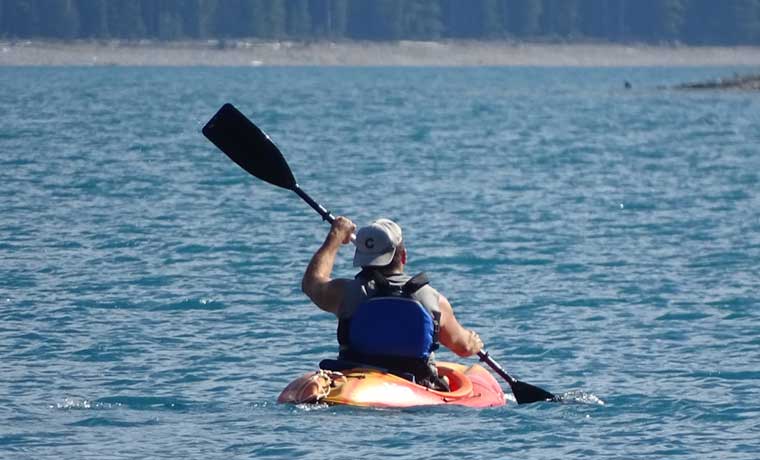
Parts of a kayak paddle explained
Blades
The blades are what goes into the water and move the kayak forwards. There is one at either end of the paddle, and the blade breaks down into two main parts:
- The power face: This side is curved upwards so that it catches the water and faces the paddler on each stroke.
- The back face: Faces away from the paddler and has a ridge (called a spine) that runs through the middle.
Paddle blades are usually made from plastic, fibreglass or carbon but the shape can vary widely. Some kayak blades are longer, narrower, or more curved than others. Additionally, kayak blades can be symmetrical or asymmetrical.
Shaft
This is what connects the two blades and what you hold onto while paddling. Paddle shafts vary in length and shape. Most paddle shafts are straight, but some are bent, offering a more comfortable handhold. Cheaper paddles usually have aluminium shafts, while more expensive paddles have fibreglass or carbon shafts.
Feathering
The feathering refers to the angle of one blade compared to the other. Some kayak paddles allow for adjustable feathering so you can choose to match or offset the blades at a preferred angle.
Grip
Some paddles have a coated section on the shaft that keeps your hands from slipping while paddling. Some have a movable foam grip on the shaft. Foam grips are also useful for beginners, so they know where to place their hands on paddle.
Throat
The throat is where the blade attaches to the shaft on either end of the paddle.
Dip rings
Found about an inch to an inch and a half above the throat, dip rings (also called drip guards) are rubber rings that stop water from running down the shaft on the upstroke.
Learning the basic anatomy of a kayak is just as useful for beginners as it is for experienced kayakers. Understanding how each part of a kayak impacts its capabilities in the water should help you choose the right kayak for your paddling abilities and general usage.
With the basic kayak anatomy in your back pocket, you shouldn’t feel out of your depth while looking for a new kayak!


